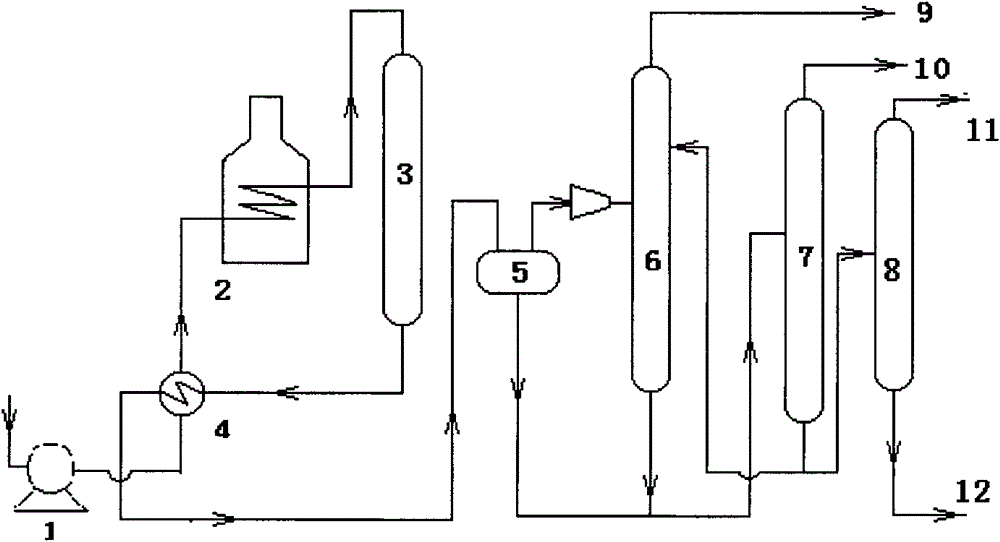Aromatization method for producing light aromatics
A light aromatics, aromatization technology, applied in chemical instruments and methods, bulk chemical production, organic chemistry, etc., can solve the problems of low conversion rate, poor combustion quality, waste of resources, etc., to achieve high conversion rate, raw material Wide range of sources and reduced dry gas yield
- Summary
- Abstract
- Description
- Claims
- Application Information
AI Technical Summary
Problems solved by technology
Method used
Image
Examples
preparation example Construction
[0033] The preferred preparation method of above-mentioned catalyst comprises the steps:
[0034] (1) After peptizing the precursor of the binder with acid, adding ZSM series zeolite and stirring to form a slurry, then dropping the slurry into an oil ammonia column to form a ball, drying and roasting the pellet to obtain a carrier,
[0035] (2) The carrier is impregnated with an impregnating solution prepared from a compound containing zinc, a compound containing rare earth elements and a compound containing group VA elements, then dried and calcined.
[0036] In the above method, step (1) is carrier preparation. First, the precursor of the binder is peptized with an acid. The acid can be nitric acid, hydrochloric acid, formic acid or acetic acid, preferably nitric acid, and the precursor of the binder is preferably pseudoboehmite. stone. When peptizing, the suitable ratio of the mass of the acid to the alumina contained in the pseudo-boehmite is 0.02-0.20:1, preferably 0.04-...
example 1
[0044] Preparation of the aromatization catalyst used in the present invention.
[0045] Get the pseudo-boehmite powder of 67.6 grams (Sasol company produces, SB, the alumina content is 74% by mass), under stirring conditions, it was added into 300 ml of nitric acid aqueous solution with a concentration of 1.1% by mass, stirred for 2 hours to peptize, and 55.0 grams of HZSM-5 with a silica / alumina molar ratio of 60 was added Zeolite powder (95% zeolite content), stirred at high speed for 3 hours. Drop the prepared slurry into an oily ammonia column containing 8% by mass of ammonia water, take out the wet ball formed in the oily ammonia column, dry at 60°C for 10 hours, and roast at 550°C for 3 hours to obtain 50% by mass of HZSM-5 zeolite and carrier pellets of 50% by mass alumina.
[0046] Get 50 grams of carrier pellets, use 60 grams of zinc nitrate containing 8.8 mass %, mixed rare earth chloride 1.3 mass % (wherein lanthanum oxide accounts for 31 mass %, cerium oxide 51...
example 2~4
[0048] The following examples carry out the evaluation of the aromatization reaction of mixed carbon four and heavy aromatics, the mixed carbon four and C used in the reaction 9 + The compositions of heavy aromatics are shown in Table 1 and Table 2, respectively.
[0049] Will 1 # Hybrid carbon four and C 9 + Heavy aromatics are mixed and loaded into the raw material tank according to a certain mass ratio, and the raw material oil is sent into the reactor by a metering pump into a 20 ml fixed-bed continuous flow reactor filled with 10 grams of catalyst A for reaction. Feed quality space velocity 0.7 hours -1 Carry out aromatization reaction under the condition of , the obtained product distribution is shown in Table 3.
PUM
 Login to View More
Login to View More Abstract
Description
Claims
Application Information
 Login to View More
Login to View More - R&D
- Intellectual Property
- Life Sciences
- Materials
- Tech Scout
- Unparalleled Data Quality
- Higher Quality Content
- 60% Fewer Hallucinations
Browse by: Latest US Patents, China's latest patents, Technical Efficacy Thesaurus, Application Domain, Technology Topic, Popular Technical Reports.
© 2025 PatSnap. All rights reserved.Legal|Privacy policy|Modern Slavery Act Transparency Statement|Sitemap|About US| Contact US: help@patsnap.com



